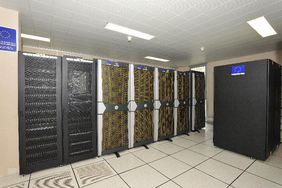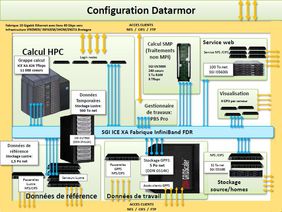The total volume of archived data is about 550 terabytes with a very significant increase of about 15 to 20% per year. This increase can be explained by three factors combined:
- The sensors deployed on marine resources (vessels, submersibles) are increasingly efficient, particularly in the domains of submarine acoustics and video, which is becoming a tool in its own right for exploration and monitoring because there is no impact on the seabed;
- Observations collected by satellite;
- Derivative products from digital calculations, generalising the observations made: geo-statistical analyses (climatology, for example), cartography and the processing of images and models.
In order to store and analyse data, the IRSI department has an intensive calculation centre, which can perform 23,000,000,000,000 elementary calculation operations per second.
From CapArmor ...
The CapArmor intensive calculation engine, co-financed by the Brittany region (contract at the State-Region level) and several partners involved in studing the marine environment (Ifremer, SHOM, Institut Universitaire Européen de la Mer, etc.) is used for several missions:
- The geo-statistical analysis of observation data (maps, for example),
- The processing of satellite data,
- Ocean modelling (currents, waves, etc.,) and modelling the behaviour of structures at sea (vessels, platforms, etc.),
- Bioinformatics (research on the genome of marine organisms).
... to Datarmor
Because CapArmor will soon be saturated, a new project (DatArmor) has been set up in order to replace it. Developed in partnership with organisations that are active in the marine domain and present at the Brittany regional level (Shom, IUEM, Université de Bretagne Occidentale, ENSTA, Ecole Navale), its financing plan has now been formally determined.
With this new calculation engine, the ambition is to:
- increase the calculation capacity,
- Increase the storage capacity (data and products),
- make the intensive and parallel processing of data possible: algorithms of the "big data" type (classifications, search, etc.), analysis and validation of the results of voluminous models, simultaneous processing of sets of data with little dependency (e.g.: data from different orbits of a satellite).
The "intensive calculations" aspects (vector, finite element calculations, etc.,) are well known to the IRSI unit, as is the storage of large volumes.


